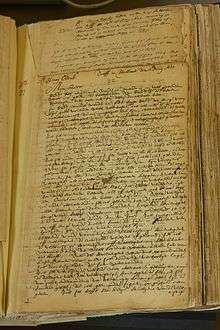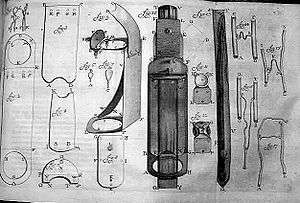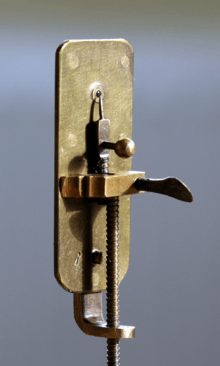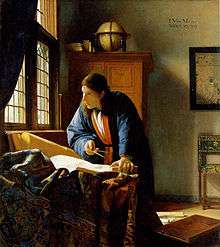Antonie van Leeuwenhoek
| Antonie van Leeuwenhoek | |
|---|---|
|
A portrait of Antonie van Leeuwenhoek (1632–1723) by Jan Verkolje | |
| Born |
24 October 1632 Delft, Dutch Republic |
| Died |
26 August 1723 (aged 90) Delft, Dutch Republic |
| Nationality | Dutch |
| Fields | Microscopist, biologist |
|
Signature | |
Antonie Philips van Leeuwenhoek[note 1] (/ˈleɪvənhʊk/, Dutch: [ɑnˈtoːni vɑn ˈleːuə(n)ˌɦuk]; 24 October 1632 – 26 August 1723) was a Dutch tradesman and scientist. He is commonly known as "the Father of Microbiology", and considered to be the first microbiologist. He is best known for his work on the improvement of the microscope and for his contributions towards the establishment of microbiology.
Raised in Delft, in the Netherlands, Van Leeuwenhoek worked as a draper in his youth, and founded his own shop in 1654. He made a name for himself in municipal politics, and eventually developed an interest in lensmaking. Using his handcrafted microscopes, he was the first to observe and describe microorganisms, which he originally referred to as animalcules (from Latin animalculum = "tiny animal").
Most of the "animalcules" are now referred to as unicellular organisms, though he observed multicellular organisms in pond water. He was also the first to document microscopic observations of muscle fibers, bacteria, spermatozoa, and blood flow in capillaries. Van Leeuwenhoek did not write any books; his discoveries came to light through correspondence with the Royal Society, which published his letters.
Early life and career
_(19122164704).jpg)
Antonie van Leeuwenhoek was born in Delft, Dutch Republic, on 24 October 1632. On 4 November, he was baptized as Thonis. His father, Philips Antonisz van Leeuwenhoek, was a basket maker who died when Antonie was only five years old. His mother, Margaretha (Bel van den Berch), came from a well-to-do brewer's family, and remarried Jacob Jansz Molijn, a painter. Antonie had four older sisters, Margriet, Geertruyt, Neeltje, and Catharina.[2] When he was around ten years old his step-father died. He attended school in Warmond for a short time before being sent to live in Benthuizen with his uncle, an attorney. At the age of 16 he became a bookkeeper's apprentice at a linen-draper's shop in Amsterdam[3] owned by the Scot William Davidson. Van Leeuwenhoek left after six years.[4][5]
Van Leeuwenhoek married Barbara de Mey in July 1654, with whom he would have one surviving daughter, Maria (four other children died in infancy). That same year he returned to Delft, where he would live and study for the rest of his life. He opened a draper's shop, which he ran throughout the 1650s. His wife died in 1666, and in 1671, Van Leeuwenhoek remarried to Cornelia Swalmius with whom he had no children.[6] His status in Delft had grown throughout the years. In 1660 he received a lucrative job as chamberlain for the Delft sheriffs' assembly chamber in the City Hall, a position which he would hold for almost 40 years. In 1669 he was appointed as a land surveyor by the Court of Holland; at some time he combined it with another municipal job, being the official "wine-gauger" of Delft and in charge of the city's wine imports[7] and (wine) taxation.
Van Leeuwenhoek was a contemporary of another famous Delft citizen, the painter Johannes Vermeer, who was baptized just four days earlier. It has been suggested that he is the man portrayed in two of Vermeer's paintings of the late 1660s, The Astronomer and The Geographer. However, others argue that there appears to be little physical similarity. Because they were both relatively important men in a city with only 24,000 inhabitants, it is likely that they were at least acquaintances, because Van Leeuwenhoek acted as the executor of Vermeer's will after the painter died in 1675.[8][note 2]
Microscopic study
While running his draper's shop, Van Leeuwenhoek wanted to see the quality of the thread better than the then-current magnifying lenses available allowed. He began to develop an interest in lensmaking, although few records exist of his early activity. Van Leeuwenhoek's interest in microscopes and a familiarity with glass processing led to one of the most significant, and simultaneously well-hidden, technical insights in the history of science.
By placing the middle of a small rod of soda lime glass in a hot flame, Van Leeuwenhoek could pull the hot section apart to create two long whiskers of glass. Then, by reinserting the end of one whisker into the flame, he could create a very small, high-quality glass sphere. These spheres became the lenses of his microscopes, with the smallest spheres providing the highest magnifications.

Recognition by the Royal Society
After developing his method for creating powerful lenses and applying them to the study of the microscopic world, Van Leeuwenhoek introduced his work to his friend, the prominent Dutch physician Reinier de Graaf. When the Royal Society in London published the groundbreaking work of an Italian lensmaker in their journal Philosophical Transactions of the Royal Society, De Graaf wrote to the journal's editor Henry Oldenburg with a ringing endorsement of Van Leeuwenhoek's microscopes which, he claimed, "far surpass those which we have hitherto seen". In response the Society published in 1673 a letter from Van Leeuwenhoek, which included his microscopic observations on mold, bees, and lice.[9]

Van Leeuwenhoek's work fully captured the attention of the Royal Society, and he began regularly corresponding with the Society regarding his observations. At first he had been reluctant to publicize his findings, regarding himself as a businessman with little scientific, artistic, or writing background, but De Graaf urged him to be more confident in his work.[10] When Van Leeuwenhoek died in 1723, he had written some 190 letters to the Royal Society, detailing his findings in a wide variety of fields, centered on his work in microscopy. He only wrote letters in his own colloquial flavor of Dutch; he never published a proper scientific paper. He strongly preferred to work alone, distrusting the sincerity of those who offered their assistance.[11] The letters were translated into Latin or English by Henry Oldenburg, who had learned Dutch in order to be able to do so. Despite the initial success of Van Leeuwenhoek's relationship with the Royal Society, this relationship was soon severely strained. In 1676, his credibility was questioned when he sent the Royal Society a copy of his first observations of microscopic single-celled organisms. Previously, the existence of single-celled organisms was entirely unknown. Thus, even with his established reputation with the Royal Society as a reliable observer, his observations of microscopic life were initially met with some skepticism.[12]
Eventually, in the face of Van Leeuwenhoek's insistence, the Royal Society arranged for Alexander Petrie, minister to the English Reformed Church in Delft; Benedict Haan, at that time Lutheran minister at Delft; and Henrik Cordes, then Lutheran minister at the Hague, accompanied by Sir Robert Gordon and four others, to determine whether it was in fact Van Leeuwenhoek's ability to observe and reason clearly, or perhaps the Royal Society's theories of life itself that might require reform. Finally in 1677,[13] Van Leeuwenhoek's observations were fully vindicated by the Royal Society.[14]
Antonie van Leeuwenhoek was elected to the Royal Society in February 1680 on the nomination of William Croone, a then-prominent physician.[note 3] Van Leeuwenhoek was "taken aback" by the nomination, which he considered a high honor, although he did not attend the induction ceremony in London, nor did he ever attend a Royal Society meeting.[16]
Scientific fame
By the end of the 17th century, Van Leeuwenhoek had a virtual monopoly on microscopic study and discovery. His contemporary Robert Hooke, an early microscope pioneer, bemoaned that the field had come to rest entirely on one man's shoulders.[17] He was visited over the years by many notable individuals, such as the Russian Tsar Peter the Great. To the disappointment of his guests, Leeuwenhoek refused to reveal the cutting-edge microscopes he relied on for his discoveries, instead showing visitors a collection of average-quality lenses.[18]
An experienced businessman, Van Leeuwenhoek believed that if his simple method for creating the critically important lens was revealed, the scientific community of his time would likely disregard or even forget his role in microscopy. He therefore allowed others to believe that he was laboriously spending most of his nights and free time grinding increasingly tiny lenses to use in microscopes, even though this belief conflicted both with his construction of hundreds of microscopes and his habit of building a new microscope whenever he chanced upon an interesting specimen that he wanted to preserve. He made about 200 microscopes with different magnification.
Van Leeuwenhoek was visited by Leibniz, William III of Orange and his wife, and the burgemeester (mayor) Johan Huydecoper of Amsterdam, the latter being very interested in collecting and growing plants for the Hortus Botanicus Amsterdam, and all gazed at the tiny creatures. In 1698, Van Leeuwenhoek was invited to visit the Tsar Peter the Great in his boat. On this occasion Van Leeuwenhoek presented the Tsar an "eel-viewer", so Peter could study the blood circulation whenever he wanted.
Techniques and discoveries

Antonie van Leeuwenhoek made more than 500 optical lenses. He also created at least 25 single-lens microscopes, of differing types, of which only nine have survived. These microscopes were made of silver or copper frames, holding hand-made lenses. Those that have survived are capable of magnification up to 275 times. It is suspected that Van Leeuwenhoek possessed some microscopes that could magnify up to 500 times. Although he has been widely regarded as a dilettante or amateur, his scientific research was of remarkably high quality.[19]
Van Leeuwenhoek's single-lens microscopes were relatively small devices, the biggest being about 5 cm long.[20][21] They are used by placing the lens very close in front of the eye, while looking in the direction of the sun. The other side of the microscope had a pin, where the sample was attached in order to stay close to the lens. There were also three screws to move the pin and the sample, along three axes: one axis to change the focus, and the two other axes to navigate through the sample.
Van Leeuwenhoek maintained throughout his life that there are aspects of microscope construction "which I only keep for myself", in particular his most critical secret of how he made the lenses. For many years no-one was able to reconstruct Van Leeuwenhoek's design techniques. However, in 1957, C.L. Stong used thin glass thread fusing instead of polishing, and successfully created some working samples of a Van Leeuwenhoek design microscope.[22] Such a method was also discovered independently by A. Mosolov and A. Belkin at the Russian Novosibirsk State Medical Institute.[23]

Van Leeuwenhoek used samples and measurements to estimate numbers of microorganisms in units of water.[24][25] He also made good use of the huge lead provided by his method. He studied a broad range of microscopic phenomena, and shared the resulting observations freely with groups such as the British Royal Society.[26] Such work firmly established his place in history as one of the first and most important explorers of the microscopic world. Antonie van Leeuwenhoek was one of the first people to observe cells, much like Robert Hooke.
Van Leeuwenhoek's main discoveries are:
- infusoria (protists in modern zoological classification), in 1674
- bacteria, (e.g., large Selenomonads from the human mouth), in 1683;[27][note 4][28][note 5]
- the vacuole of the cell
- spermatozoa in 1677
- the banded pattern of muscular fibers, in 1682
In 1687, Van Leeuwenhoek reported his research on the coffee bean. He roasted the bean, cut it into slices and saw a spongeous interior. The bean was pressed, and an oil appeared. He boiled the coffee with rain water twice and set it aside.[29]
Like Robert Boyle and Nicolaas Hartsoeker, Van Leeuwenhoek was interested in dried cochineal, trying to find out if the dye came from a berry or an insect.[30][31][32]
Antonie van Leeuwenhoek's religion was "Dutch Reformed" Calvinist.[33] He often referred with reverence to the wonders God designed in making creatures great and small. He believed that his amazing discoveries were merely further proof of the great wonder of God's creation.[34][35]
Death and legacy
By the end of his life, Van Leeuwenhoek had written approximately 560 letters to the Royal Society and other scientific institutions concerning his observations and discoveries. Even during the last weeks of his life, Van Leeuwenhoek continued to send letters full of observations to London. The last few contained a precise description of his own illness. He suffered from a rare disease, an uncontrolled movement of the midriff, which is now named Van Leeuwenhoek's disease.[36] He died at the age of 90, on 26 August 1723, and was buried four days later in the Oude Kerk in Delft.
In 1981, the British microscopist Brian J. Ford found that Van Leeuwenhoek's original specimens had survived in the collections of the Royal Society of London. They were found to be of high quality, and were all well preserved.[37][38][39] Ford carried out observations with a range of single-lens microscopes, adding to our knowledge of Van Leeuwenhoek's work.[40]
The Antoni van Leeuwenhoek Hospital in Amsterdam, named after Van Leeuwenhoek, is specialized in oncology.[41]
On 24 October 2016, Google commemorated Van Leeuwenhoek's 384th birthday with a Doodle that depicted his discovery of "little animals" or animalcules, now known as bacteria.[42]
See also
Notes
- ↑ The spelling of Van Leeuwenhoek's name is exceptionally varied. He was christened as Thonis, but always went by Antonj (corresponding with the English Antony). The final j of his given name is the Dutch tense i. Until 1683 he consistently used the spelling Antonj Leeuwenhoeck (ending in –oeck) when signing his letters. Throughout the mid-1680s he experimented with the spelling of his surname, and after 1685 settled on the most recognized spelling, Van Leeuwenhoek.[1]
- ↑ In A Short History of Nearly Everything (p. 236) Bill Bryson alludes to rumors that Vermeer's mastery of light and perspective came from use of a camera obscura produced by Leeuwenhoek. This is one of the examples of the controversial Hockney–Falco thesis, which claims that some of the Old Masters used optical aids to produce their masterpieces.
- ↑ He was also nominated as a "corresponding member" of the French Academy of Sciences in 1699, but there is no evidence that the nomination was accepted nor that he was ever aware of it.[15]
- ↑ The "Lens on Leeuwenhoek" site, which is exhaustively researched and annotated, prints this letter in the original Dutch and in English translation, with the date 17 September 1683. Assuming that the date of 1676 is accurately reported from Pommerville (2014), that book seems more likely to be in error than the intensely detailed, scholarly researched website focused entirely on Van Leeuwenhoek.
- ↑ Sixty-two years later, in 1745, a physician correctly attributed a diarrhea epidemic to Van Leeuwenhoek's "bloodless animals" (Valk 1745, cited by Moll 2003).
References
- ↑ Dobell, pp. 300–305.
- ↑ Dobell, pp. 19–21.
- ↑ Dobell, pp. 23–24.
- ↑ The curious observer. Events of the first half of van Leeuwenhoek's life. Lens on Leeuwenhoek (1 September 2009). Retrieved 20 April 2013.
- ↑ Huerta, p. 31.
- ↑ Dobell, pp. 27–31.
- ↑ Dobell, pp. 33–37.
- ↑ Van Berkel, K. (24 February 1996). Vermeer, Van Leeuwenhoek en De Astronoom. Vrij Nederland (Dutch magazine), p. 62–67.
- ↑ Dobell, pp. 37–41.
- ↑ Dobell, pp. 41–42.
- ↑ Dobell, pp. 43–44.
- ↑ The unseen world: reflections on Leeuwenhoek (1677) Concerning little animals
- ↑ Schierbeek, A.: "The Disbelief of the Royal Society." Measuring the Invisible World. London and New York: Abelard-Schuman, 1959. N. pag. Print.
- ↑ Full text of "Antony van Leeuwenhoek and his "Little animals"; being some account of the father of protozoology and bacteriology and his multifarious discoveries in these disciplines;". Recall.archive.org. Retrieved 20 April 2013.
- ↑ Dobell, pp. 53–54.
- ↑ Dobell, pp. 46–50.
- ↑ Dobell, pp. 52–53.
- ↑ Dobell, pp. 54–61.
- ↑ Brian J. Ford (1992). "From Dilettante to Diligent Experimenter: a Reappraisal of Leeuwenhoek as microscopist and investigator". Biology History. 5 (3).
- ↑ Anderson, Douglas. "Tiny Microscopes". Lens on Leeuwenhoek. Archived from the original on 2 May 2015. Retrieved 3 March 2016.
- ↑ Lens on Leeuwenhoek: How he made his tiny microscopes. Lensonleeuwenhoek.net. Retrieved 15 September 2013.
- ↑ "A glass-sphere microscope". Funsci.com. Archived from the original on 11 June 2010. Retrieved 13 June 2010.
- ↑ A. Mosolov & A. Belkin (1980). "Secret of Antony van Leeuwenhoek?". Nauka i Zhizn (Science and Life). 09-1980: 80–82.
- ↑ F. N. Egerton (1967). "Leeuwenhoek as a founder of animal demography". Journal of the History of Biology. 1: 1–22. doi:10.1007/BF00149773. JSTOR 4330484.
- ↑ Frank N. Egerton (2006). "A History of the Ecological Sciences, Part 19: Leeuwenhoek's Microscopic Natural History". Bulletin of the Ecological Society of America. 87: 47. doi:10.1890/0012-9623(2006)87[47:AHOTES]2.0.CO;2.
- ↑ "Robert Hooke (1635–1703)". Ucmp.berkeley.edu. Retrieved 13 June 2010.
- ↑ Anderson, Douglas. "Wrote Letter 39 of 1683-09-17 (AB 76) to Francis Aston". Lens on Leeuwenhoek. Archived from the original on 20 August 2016. Retrieved 26 September 2016.
- ↑ Pommerville, Jeffrey (2014). Fundamentals of microbiology. Burlington, MA: Jones & Bartlett Learning. p. 6. ISBN 978-1-4496-8861-5.
- ↑ 9 May 1687, Missive 54.
- ↑ Antoni van Leeuwenhoek; Samuel Hoole (1800). The Select Works of Antony van Leeuwenhoek, Containing His Microscopical Discoveries in Many of the Works of Nature. G. Sidney. pp. 213–.
- ↑ Rocky Road: Leeuwenhoek. Strangescience.net (22 November 2012). Retrieved 20 April 2013.
- ↑ Greenfield, Amy Butler (2005). A Perfect Red: Empire, Espionage, and the Quest for the Color of Desire. New York: Harper Collins Press. ISBN 0-06-052276-3
- ↑ "The religious affiliation of Biologist A. van Leeuwenhoek". Adherents.com. 8 July 2005. Archived from the original on 7 July 2010. Retrieved 13 June 2010.
- ↑ "The Religion of Antony van Leeuwenhoek". 2006. Archived from the original on 4 May 2006. Retrieved 23 April 2006.
- ↑ A. Schierbeek, Editor-in-Chief of the Collected Letters of A. van Leeuwenhoek, Measuring the Invisible World: The Life and Works of Antoni van Leeuwenhoek F R S, Abelard-Schuman (London and New York, 1959), QH 31 L55 S3, LC 59-13233. This book contains excerpts of Van Leeuwenhoek's letters and focuses on his priority in several new branches of science, but makes several important references to his spiritual life and motivation.
- ↑ Life and work of Antoni van Leeuwenhoek of Delft in Holland; 1632–1723 (1980) Published by the Municipal Archives Delft, p. 9
- ↑ Biology History vol 5(3), December 1992
- ↑ The Microscope vol 43(2) pp 47–57
- ↑ Spektrum der Wissenschaft pp 68–71, June 1998
- ↑ "The discovery by Brian J Ford of Leeuwenhoek's original specimens, from the dawn of microscopy in the 16th century". Brianjford.com. Retrieved 13 June 2010.
- ↑ Antoni van Leeuwenhoek (in Dutch). Retrieved 25 October 2016.
- ↑ New Google Doodle Celebrates Antoni van Leeuwenhoek, Inventor of Microbiology, Retrieved 24 October 2016.
Sources
- Dobell, Clifford (1960) [1932]. Antony van Leeuwenhoek and His "Little Animals": being some account of the father of protozoology and bacteriology and his multifarious discoveries in these disciplines (Dover Publications ed.). New York: Harcourt, Brace and Company.
- Ford, Brian J. (1991). The Leeuwenhoek Legacy. Bristol and London: Biopress and Farrand Press.
- Huerta, Robert (2003). Giants of Delft: Johannes Vermeer and the Natural Philosophers: The Parallel Search for Knowledge during the Age of Discovery. Pennsylvania: Bucknell University Press.
- Moll, Warnar (2003). "Antonie van Leeuwenhoek". Onderzoeksportal [Research Portal]. University of Amsterdam. Archived from the original on 2004-02-18. Retrieved 3 March 2016.
Indeed, in this publication "Geneeskundig Verhaal van de Algemeene Loop-ziekte..." [Valk (1745)], the author uses the work of Leeuwenhoek in describing the disease, draws some (preliminary) conclusions about the cause of the disease, he warns "non-believers of Van Leeuwenhoek to use a magnifying glass" and gives commentaries on the work of Anthonie van Leeuwenhoek and his findings.
- Payne, Alma Smith (1970). The Cleere Observer: A biography of Antoni van Leeuwenhoek. London: Macmillan.
- Ruestow, Edward G (1996). The Microscope in the Dutch Republic: The Shaping of Discovery. New York: Cambridge University Press.
- Snyder, Laura J. (2015). Eye of the Beholder: Johannes Vermeer, Antoni van Leeuwenhoek, and the Reinvention of Seeing. New York: W. W. Norton & Company.
- Valk, Evert (1745). Een geneeskundig verhaal van de algemeene loop-ziekte, die te Kampen en in de om-geleegene streeken heeft gewoed in 't jaar 1736 neevens een werktuigkunstige, en natuurkundige beschryvinge van de oorzaak, uitwerking en genezinge waar in word aan-getoond, dat dezelve, waarschynlyk, door bloed-loose diertjes, beschreven in de werken van Anthony van Leeuwenhoek, het werd te weeg gebragt, en door kwik voor-naamentlyk, uit-geroeid [A work on a disease in the city of Kampen in 1736 caused by "little animals". These bloodless animals are most likely the little animals described in the work of Leeuwenhoek and they can be killed by treatment of mercury] (in Dutch). Haarlem: Van der Vinne. p. 97. Retrieved 3 March 2016.
External links
| Wikisource has original works written by or about: Antonie van Leeuwenhoek |
| Wikimedia Commons has media related to: |
- Leeuwenhoek's letters to the Royal Society
- The Correspondence of Anthonie van Leeuwenhoek in EMLO
- Lens on Leeuwenhoek (site on Leeuwenhoek's life and observations)
- Vermeer connection website
- University of California, Berkeley article on Van Leeuwenhoek
- Works by Antoni van Leeuwenhoek at Project Gutenberg
- Works by or about Antonie van Leeuwenhoek at Internet Archive
- Retrospective paper on the Leeuwenhoek research by Brian J. Ford.
- Images seen through a Van Leeuwenhoek microscope by Brian J. Ford.
- Instructions on making a Van Leeuwenhoek Microscope Replica by Alan Shinn
._Natuurkundige_te_Delft_Rijksmuseum_SK-A-957.jpeg)


